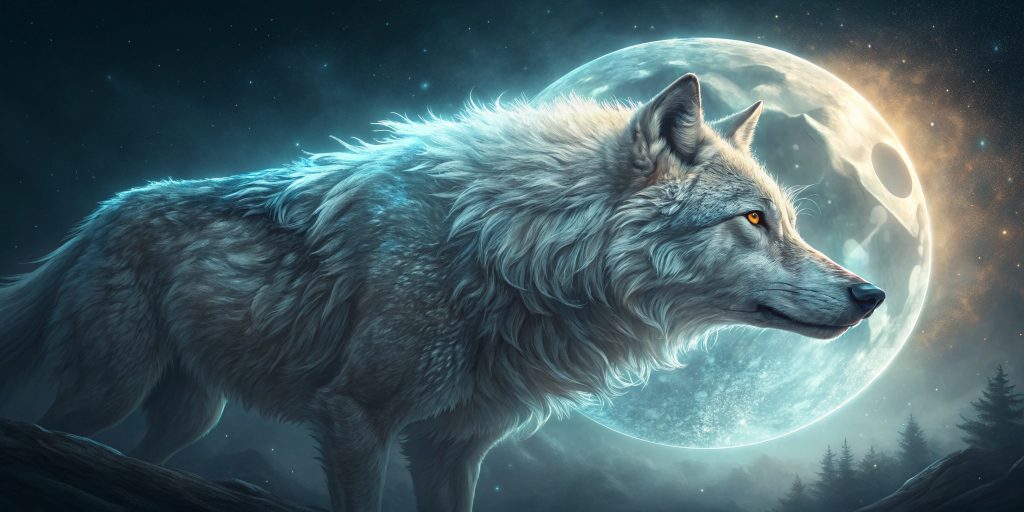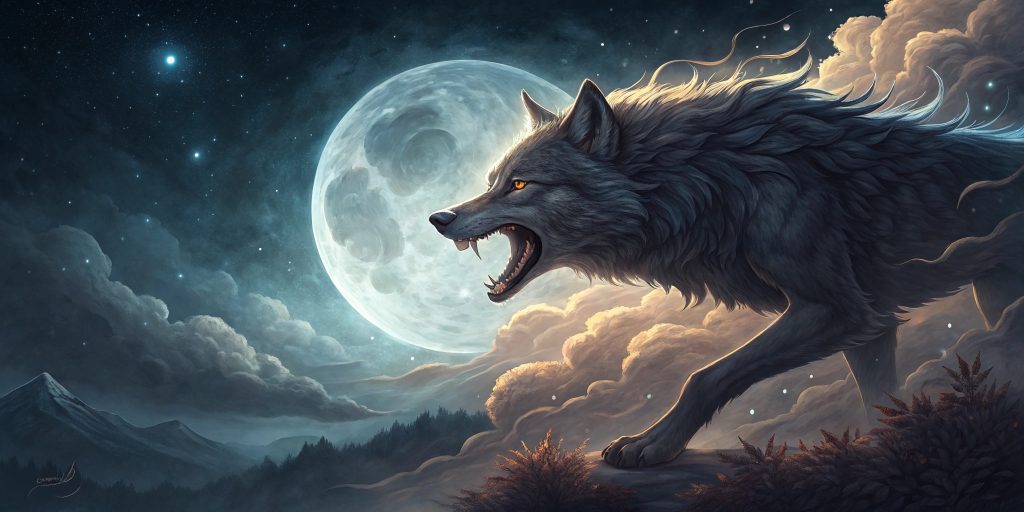Creatures in Norse mythology, Fenrir, Norse Mythology, Skoll and Hati
Who Is Hati Wolf?
In Norse mythology, Hati, the wolf, is a key figure. He is known for chasing the moon without rest and symbolizes the magic of the night sky.
In Old Norse, “Hati” means “the one who hates.” This name reflects his fierce and intense nature. His story is linked to the balance between order and chaos in Norse tales.
Hati’s role in these stories is important. He is a part of the cosmic drama, especially in the events of Ragnarök.
So, is Hati god? Keep reading this article to find out.
Introduction to Hati Wolf
Hati Wolf is a key figure in Norse mythology. He shows the endless battle between light and dark. This introduction to Hati gives us a peek into his character and the stories around him.
In Norse myths, Hati is more than just a wolf. He stands for the themes of chase and fate. Along with Sköll, who chases the sun, Hati’s pursuit of the moon tells us about nature’s cycles and the universe’s forces.
This look at Hati shows he’s not just a wolf. He’s a big part of the myths, connected to other characters. The tales of Hati help us understand ancient beliefs and the universe’s mysteries.
The Origins of Hati Norse Mythology
Hati’s story begins in Norse mythology, and his character comes from a rich mythological background. The Völuspá poem introduces Hati, showing the Norse world and its creatures.
Snorri Sturluson’s Prose Edda adds more to Hati’s story and places him in the big story of the universe.
Hati comes from Fenrir, a key figure in Norse stories. This shows Hati’s role in the myths of creation. His story is about the fight between light and darkness in Norse myths.
Texts say Hati is meant to chase the moon, which was important in Norse beliefs. Knowing Hati’s place in Norse myths shows his deep meaning in ancient stories.
Hati the Wolf: The Celestial Chaser of the Moon
Hati is a key figure as the moon’s relentless pursuer. His story shows the balance between day and night and highlights the importance of celestial events in ancient beliefs.
The Role of Hati in the Cosmos
Hati represents the eternal battle between light and darkness. Every night, he chases the moon, showing nature’s inevitability. This chase shows how the cosmos and our fates are connected.

Hati’s Parentage and Connection to Fenrir
Hati’s family ties reveal a deep connection to Fenrir, the fearsome wolf. This bond explains Hati’s fierce nature and chaotic actions. His story reflects the complex tales of Norse mythology.
The Significance of the Wolf that Chases the Moon
Hati’s chase of the moon is critical in Norse mythology. It shows the balance between light and dark, and Hati’s symbolism shows how the universe works in harmony.
Hati always chases Máni, the moon. This chase talks about:
- The power of prophecy in Norse stories.
- The idea that fate is set, and we can’t change it.
- The balance of nature shows how the universe stays in order.
This chase is key to understanding Norse mythology. It shows how life is a constant dance of light and dark. Hati’s chase helps us see the deep stories of fate, cycles, and balance in Norse tales.
The Relationship Between Hati and Sköll
Hati and Sköll are key in Norse mythology. They are the moon and sun wolves. They chase each other, showing the balance between day and night.
The Mythological Narrative of Two Wolves
Hati and Sköll’s story is deep. They show the balance needed for our world. Hati chases the moon, revealing nature’s power.
- Their chases are not just physical. They also show the fight between light and dark.
- They need each other for the world to be in balance.
- In Ragnarök, they play big roles. Their actions show their importance in the myth.
Hati and Sköll show the rich world of Norse cosmology. Their stories tell us about existence and nature.
Hati’s Depiction in Eddic Poems
In Norse mythology, Hati is a powerful figure in Eddic literature. The Poetic Edda and Prose Edda show us Hati’s role as a moon hunter, highlighting the importance of his chase in Norse culture.
Analysis of the Poetic Edda and Prose Edda
The Eddic poems discuss Hati’s bond with the stars. In the Poetic Edda, we see Hati’s never-ending chase, which shows the time cycle.
The Prose Edda adds more to Hati’s story. It tells us that Hati and Sköll fight between light and dark. Their stories are creatively told, showing Hati’s importance in Norse myths.
Hati in the Context of Ragnarök
Hati’s role in Norse mythology is key in Ragnarök, the myth of the world’s end. In these events, Hati is more than just a moon chaser. He is a symbol of destruction and fate.
The Ragnarok myth shows Hati and Sköll chasing Máni, the moon. This chase leads to cosmic chaos, reflecting the themes of pursuit and destruction.
There are different views on Hati’s fate in Ragnarök. Some see it as a sign of despair, others as a sign of renewal. His chase shows the power of time and the cycle of life and death in Norse myths.
Hati’s role in Ragnarök shows how all mythic figures are connected. His chase is part of a bigger story in Norse tales, and everything is connected in the story of Ragnarök.
Physical Characteristics of Hati Wolf
Hati, the wolf of Norse legend, has traits that make him stand out. Ancient texts describe him as noble and fierce. He represents the chase between the sky and the moon.
These traits show Hati’s importance in Norse culture and highlight the role of wolves in Norse stories.
Execution of the Mythological Form of Wolves
Hati is known for his tall and agile body. His fur shines like the moon. His sharp eyes show his keen awareness and fierce spirit.

Key traits of Hati include:
- Large and powerful frame, capable of swift movement
- Fur resembling the glow of moonlight, enhancing his celestial identity
- Intense gaze that reflects intelligence and ferocity
Artists and poets have depicted Hati’s traits for centuries, keeping his essence the same. Hati’s form shows the mix of beauty and fear in myths.
Knowing Hati’s traits helps us see wolves’ symbolic role in Norse myths. They are seen as messengers and agents of chaos. This understanding deepens our view of Hati’s place in Norse mythology.
Symbols and Interpretations of Hati Mythology
Hati’s symbols emphasize the deep connection between light and darkness, a theme throughout his work. He is a wolf in the sky, depicting fights between night and day.
The chase Hati is always in shows big dualities in Viking culture. It shows the heart of life in Norse stories.
Hati’s story is reflected in many ways in Norse myths. His endless chase of the moon shows the fight between different forces and the cycles of life and time.
Hati’s story has lasted through time, showing our love for myths and the sky’s patterns.
- The chase symbolizes the balance between creation and destruction.
- Links to themes of fate and destiny in Norse tales.
- Depicts the dual nature of existence in a cosmic context.
In today’s view, Hati’s story has grown but still connects to old tales. This keeps our love for Hati’s complex story and his place in Norse myths alive.
Final Words
Hati is a key Norse mythology figure known as a celestial hunter. His endless chase of the moon shows the battle between chaos and order. This battle is a big part of Norse stories about life and death.
Hati’s story is connected to many other beings in Norse myths. He shows how these creatures are linked together. This connection is important in understanding Norse mythology.
Hati’s legend has also influenced today’s culture. His story is told in books, art, and movies, showing how old myths still inspire us today.
Learning about Hati teaches us about the power of myths. They tell us about the human experience in a deep way. Hati reminds us of our curiosity about the universe and our place in it.

